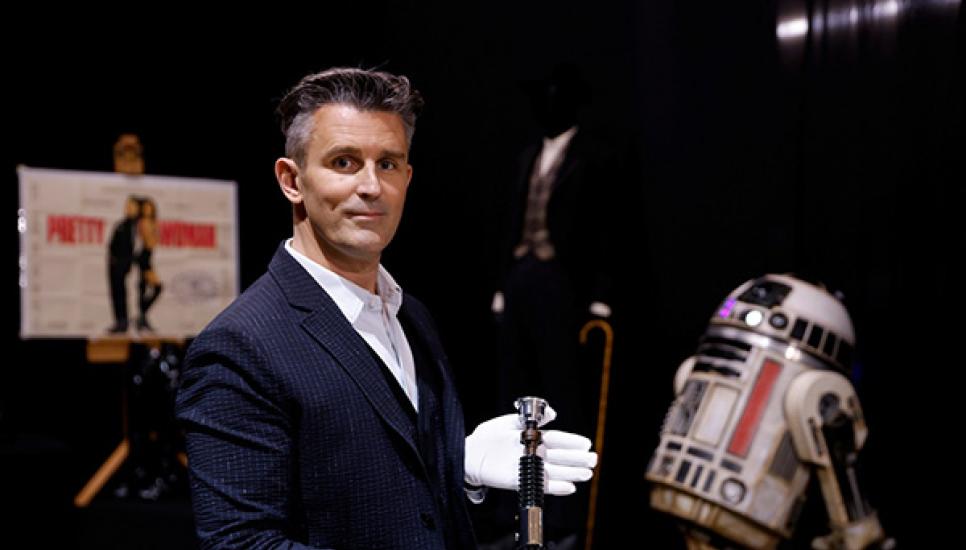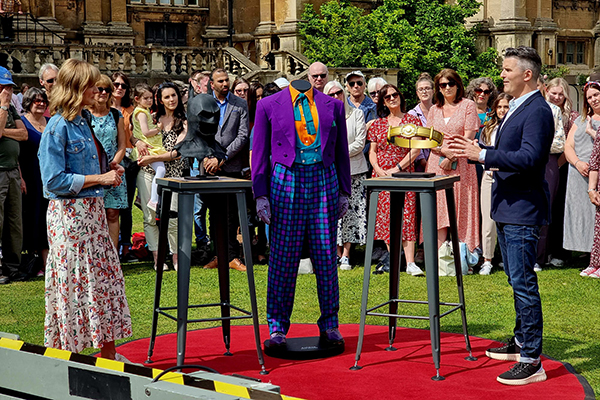How 'Prop art' became a seriously entertaining passion investment

As the CEO and founder of Propstore, Stephen Lane has grown his firm from a cottage industry into one of the world’s leaders in entertainment memorabilia. 25 years after establishing the company and after he and his team have unearthed and put to auction some of the most valuable and exciting artifacts from the history of film and television, Stephen is rightly recognised as one of the foremost experts in his field.
With nostalgia and appreciation playing their part, the value of many of these unique items have grown massively over the decades, leading investors to recognise ‘Prop art’ as an asset class in its own right – with valuations comparable or exceeding classic works of art.
Here, Stephen Lane talks about the growth of this passion investment field, the importance of authenticity and the pitfalls to avoid when searching for that perfect piece.

You’ve seen the world of entertainment memorabilia explode in popularity over the years. What’s the reason for this?
Numerous influencing factors have significantly impacted the demand for entertainment memorabilia over the past 15 years…
Buyer awareness – the fact that you can own an artefact that was used in the production of your favourite film or TV show or used on stage or in a music video by your favourite band has now reached awareness of the masses. For decades, this business was considered a niche market driven by passionate hardcore collectors, discussed solely within collectors groups and fandom-related media. Last year, I was featured as a specialist guest on a couple of episodes of The Antiques Roadshow and, on one of those episodes, we presented Jack Nicholson’s Joker costume from Tim Burton’s Batman from 1989 (with a value of £200,000), attracting 6.1 million viewers, with the clip of that segment going viral online. With significant numbers of buyers entering the market regularly, many from outside the traditional collector’s markets, demand and engagement are increasing exponentially.
Engaging content - The artefacts we offer are fun and engaging. It’s hard to find somebody who wouldn’t get excited about seeing Captain America’s shield, Darth Vader’s helmet or Noel Gallagher’s Oasis guitar in your home cinema, board room, exhibition or museum. The very nature of the content plays very well with the press, too; these items are incredibly visual and have very interesting stories attached to them.
Propstore – We’ve been leading the charge with sourcing and promoting this content since I founded the company in 1998. We’ve now become recognised as the world’s leading auction house specialising in this field and the gold standard for authenticity – bringing more confidence and opportunity within the market.
The current total Global Collectibles Market (all forms of collectables) is estimated to be £400bn – growing to $550 billion by 2028.
Prop art collecting seems to be the very definition of ‘Passion investment’. Do you find that these pieces are being bought for the love of the artefact or their future saleability?
Without question, the market was established through the demand from passionate and driven cinephiles, melomaniacs and hardcore collectors looking to reconnect with an experience like seeing your favourite band on stage for the first time or perhaps sitting in the cinema as a kid, watching Christopher Reeve as Superman with your folks back in 1978. Nothing is more emotive than the nostalgia related to these moments in time. Nothing brings you closer to reconnecting with them than acquiring an artefact directly associated with the creation of those memories – an original piece of Kryptonite, for example.
The market has evolved and developed, and values continue to significantly rise year on year, so while those buyers are still very much active, we see engagement from many other sectors, including investors, museums, institutions, fractional investment firms, private and corporate archives, entrepreneurs, prominent industry professionals and celebrities and other corporate entities.
The current total Global Collectibles Market (all forms of collectables) is estimated to be £400bn – growing to $550 billion by 2028. The existing Entertainment Memorabilia (props, costumes and music) market is estimated to be between $400-$800 million, and I expect it to substantially outpace the general market growth. Even though the landscape has changed significantly, and values have increased, I’m still firmly in the opinion that it is an emerging market with huge potential growth for investors.
A crew member purchased one of Jack Nicholson’s axes from Stanley Kubrick’s The Shining for £5... We sold it in 2019 for £170,000.
Can you talk about the process of locating props?
Assets used in films and TV shows and by bands when on tour or for music videos were considered a by-product of the production process for decades. The product was the show, and once that wrapped, these artefacts would be sold off to cast and crew or returned to rental houses, so material from the 1960s through the early 2000s is spread far and wide. During this period, crew would acquire these items for their utility, not their future potential collectable value.
A couple of good examples: A crew member purchased one of Jack Nicholson’s axes from Stanley Kubrick’s The Shining for £5 to use as a wood chopping axe. When I met him some 30 years later, he still used it to chop logs occasionally. We sold this subsequently in 2019 for £170,000. Another crew member worked on all James Bond films starring Roger Moore. At the end of each production, he would buy Moore’s shirts for £1 each. He bought them as they were the latest fashion and thought he would wear them. As it turned out, they hung in his wardrobe for a couple of decades without being further worn, and we sold each shirt for him for thousands of pounds.
Today, producers are significantly more aware of the intrinsic asset value. Even though we’re still working with a vast network of crew members and rental companies who service the industries, we also partner with some of the world's largest studios and film companies, including Warner Brothers, Legendary, Marvel and Disney, to source content.
Additionally, due to the significant increases in value over the past years, the original buyer pool has become a key part of the supply chain. Propstore has been selling to collectors since 1998. We’re keenly aware of collections and content worldwide and constantly engage in dialogue to draw that material back to the market.
So, procurement is a multi-faceted function and involves many of my 75-strong team, across our busy offices in London and Los Angeles.
How important is authenticity and provenance and how do you do your due diligence?
Authenticity and provenance are critical to buyer and market confidence and, in turn, value, and value growth.
Initially, we need to understand the source and the journey the artefact has taken to arrive at Propstore – the provenance – has it come from a crew member, did it come from the maker, a rental house or the production company or distributor?
The next step is to look at the construction method and materials. We have more than 150 years of combined experience through our in-house experts, who will review these items and ensure that they match prior known examples and are correct to their period while comparing to our library of behind-the-scenes stills.
We’ll review and discuss some items with our extensive network of industry professionals, those who were directly involved with their construction or worked on the show they originate from.
We’re then working with the latest reference and technology. For example, comparing the stitching in the threads on the bow of Indiana Jones’ Fedora from Raiders Of The Lost Ark or matching the woodgrain on the Cricket bat used by Simon Pegg in Sean Of The Dead – often to a forensic level, combing through reference books and going frame by frame through Blu-rays and 4k-resolution copies of films.
This attention to detail and consideration enables Propstore to offer every item we sell with a lifetime money-back guarantee of authenticity, providing the end user with absolute confidence. This is how we have become recognised as the gold standard in this field.
The film industry continues to evolve… so we’re constantly actively engaging and conversing with new potential partners.
Reputation is clearly key. How do you go about fostering the relationships with studios and filmmakers?
I’ve been building these relationships with studios and filmmakers for nearly 30 years, so many of these are now seriously established. Of course, the film industry continues to evolve and change, with new production companies regularly emerging, so we’re constantly actively engaging and conversing with new potential partners. Our brand strength and trading history, and performance often help in this regard. Our corporate philosophies ensure that any partner content is delivered to the market to the highest standard every time. We want these artefacts to shine as they do when seen on the big (or small) screen, and we strive for perfection.
Do collectors come to you looking for specific items? What genres are of particular interest to investors and collectors?
Yes. Considering the back catalogue of hundreds of thousands of items we’ve sold over the past 25 years, we can often accommodate. That said, it can be tricky when the request is ultra-specific, for example, not just something from The Shawshank Redemption but the rock hammer Bible from that film, as we know that only one was ever made, and the owner isn’t looking to sell. In those instances, the conversation often navigates to a more general focus once there’s a deeper understanding of the limitations on supply.
Some of the most popular genres are Science Fiction, Action and Superhero, as the assets made for these films are often designed and custom-made specifically for that production and clearly identifiable on-screen – think Robert Downey Jr’s Iron Man helmet from The Avengers, for example.
Investors may consider items more likely to transcend the generations, which can improve the likelihood of future market appeal. For example, successful franchises like Batman, Aliens, Star Wars, James Bond, Star Trek etc. These properties have a continual stream of new audience content, promoting an ongoing relationship and engagement with the collector’s/investors’ market – creating awareness and a constant stream of demand for new and old collectors alike.
Do your research… If something looks too good to be true, it likely is.
What are the pitfalls to avoid when jumping into this kind of investment?
‘Wanting to believe’ is a phrase we’ll often reference as a major pitfall. Essentially if an item looks too good to be true, then it likely is. If you see Tom Holland’s Spider-Man costume on eBay for £5,000, then in all probability, it’s a fake or a replica and should be avoided. Some key pointers:
- Buy from a reputable source that provides a widely accepted Certificate of Authenticity or specific provenance and history details.
- Buy for enjoyment as well as growth. You can achieve immense pleasure from owning these rare, interesting and engaging artefacts, which should be considered part of the equation.
- Buy to the top of your budget - the very best content will always be in demand – buy one item at £x rather than two items at ½ £x, for example.
- Resist the temptation to impulse buy. Research – there are a wealth of online articles, groups and data points to review – if something looks too good to be true, it likely is.
Once an artefact has been authenticated and purchased, what kind of growth in value can investors expect to make over, say a 10–20-year period?
Entertainment memorabilia is an emerging market with fast-growing awareness that drives mass levels of new interest into the top of the funnel. Compared to other collectable markets, top-tier items are unique or exist in only very limited supply, setting up potential for exponential growth as the market develops.
With film and television one of the biggest entertainment industries in the world and as more people with disposable income become aware of this field, the potential value growth to come for investors is still huge.
These are a few examples of growth rates referencing historical sale results:
Star Wars: The Empire Strikes Back - Darth Vader helmet. Compound annual growth rate (CAGR) 68.3%:
2003 - £92,000
2017 - £600,000
2020 - £2.86 million
Elf - Buddy The Elf (Will Ferrell) costume. CAGR 70.9%:
2003 - £6,000
2017 - £28,000
2021 - £241,500
Superman The Movie - Superman (Christopher Reeve) costume. CAGR 25.02%:
2005 - £15,000
2018 - £160,000
2022 - £312,500
We forecast that these trends will continue and that many of the artefacts currently in the mid-six-figure range could comfortably become seven-figure pieces in the years ahead.
What’s your favourite piece in your personal collection? And would you ever sell it?
I’ve been collecting for some 30 years, so I have a reasonably extensive and eclectic collection; favourites include John Hurt’s space suit from Alien, Gimli’s axe from The Lord Of The Rings and Russell Crowe’s shield from Gladiator. That said, the majority of my personal collection is Star Wars-orientated as that’s the film I connected with as a goggle-eyed seven-year boy sitting in the Empire Leicester Square when I saw it for the first time back in 1977.
My favourite piece has to be Darth Vader’s screen-matched hero lightsaber from The Empire Strikes Back. The very lightsaber that Vader is holding when he reveals to Luke that he is his father – possibly one of the most memorable reveals in modern film.
As Propstore has been purely self-financed, I’ve had to sell many items from my collection to fund the growth and development of the business, so I’ll always consider any serious offer.
I also very much appreciate that we’re all only temporary custodians of any of our possessions. When it’s time to sell something from my collection, I get a genuine thrill seeing the joy on the new owners’ face.






